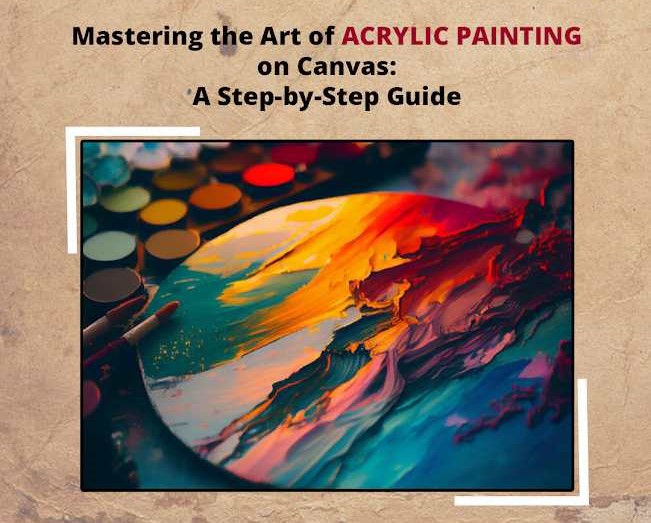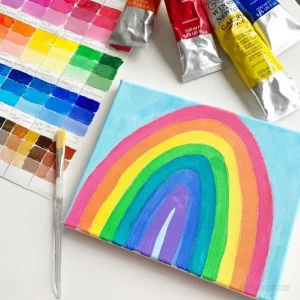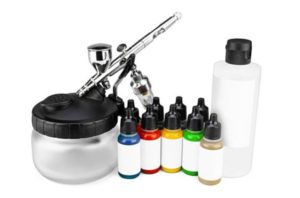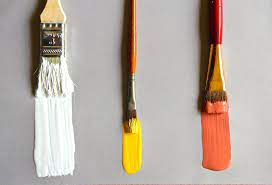
A Step-by-Step Guide to Mastering Acrylic Painting on Canvas
Imagine yourself with a blank canvas, a palette full of brilliant colors, and the opportunity to transform your ideas into a striking work of art. Canvas painted with acrylics provides an exciting journey into an infinite creative and self-expression realm. It’s a symphony of brushstrokes, a dance of color and texture that conveys ideas and feelings. Acrylics on canvas are your ticket to a world where your greatest creative aspirations come true, regardless of your experience level in this fascinating field. Now let’s take a walk on the road of acrylics.
Unlocking Endless Creativity – Your Expressive Journey Begins Here!
Step 1: Setting up the look
1) Assemble Your Materials: You’ll need to gather your supplies before you can start working on your acrylic masterpiece. This is a basic list to help you get going:
1. Paints in acrylic
2.Canvas Headgear
3.Color Scheme
4.Use acrylic medium or water to mix
5.Simple
6.Rakes or paper towels
7.For cleaning, use acrylic medium or water.
2) Selecting a Canvas: Acrylic paints are suitable for a variety of surfaces, although canvas is a popular option because of its robustness and texture. A variety of sizes and shapes of canvas panels and stretched canvases are available for selection. Choose the one that best captures your idea for the painting.
Realted Articles : Choosing the best acrylic paint for beginners.
Step 2: Knowing How to Use Acrylic Paints

The most loved feature of acrylic paints is the vibrancy of its color and the quick drying time.
1) Color mixing: A variety of colors can be easily created by combining acrylics. Invest in white, black, and the primary colors—yellow, blue, and red—to create an almost limitless palette.
2) Consistency: Different consistencies of acrylics can be obtained by thinning them with water or acrylic medium. Palette knives can be used to apply thicker paint for texture and thinner paint for translucent washes.
3) Drying Time: Acrylics require rapid drying, so productivity is key. To prolong your working window and slow down the drying process, think about using acrylic retarders.
Step 3: Setting Up Your Work Area
Creating a comfortable workspace is essential to a productive acrylic painting session:
1) Easel: To avoid straining your neck and back, make sure your canvas is at eye level by investing in a high-quality easel.
2) Lighting: Adequate lighting is crucial. The most accurate representation of color is achieved with natural light or daylight-simulating bulbs.
3) Protective Gear: To avoid paint getting on your skin or clothing, wear worn-out clothes and a pair of gloves
Step 4: Brushwork and Techniques
1) Picking the Right Brush: Every Paint brush has a distinct function. Round brushes are ideal for fine details, and flat brushes work well for bold strokes. Try out different brushes to determine which one works best for your painting.
2) Brush Methods: To add various textures and effects to your acrylic paintings, master brush techniques like layering, stippling, and dry brushing.
3) Blending and Layering: Layering and blending are possible with acrylics. Work your way forward, starting with the background and letting each layer dry before adding the next.
Related Artcles : Complete guide on how to use paint brush.
Step 5: How to Make Your Masterpiece
1) Draw Your Concept: Start by using a pencil to lightly sketch your composition on the canvas. This will function as a blueprint for your artwork.
2) Blocking In: Work your way toward the foreground by starting with the background colors. Now is the time to concentrate on the composition as a whole rather than the specifics.
3) Detailing: After the foundation layers are completely dry, begin highlighting and adding details. To ensure accuracy, take your time and use smaller brushes.
4) Texture and Depth: When applied with a palette knife or other tools, acrylics can produce texture. Try out these methods to give your painting more depth and appeal.
5) Problem-solving and Advice
1.Errors Do Happen: Don’t let errors demotivate you. Acrylic paints are tolerant. Once they’re dry, you can paint over them or remove any layers you don’t like.
2.Play around: Creating acrylics is all about playing around. Explore a variety of methods, hue combinations, and instruments to find your own style .
3.Safeguard Your Work: After your painting is finished, coat it with varnish to keep dust and UV rays away. This also makes your colors more vibrant.
Related Artcle : Guide of Choosing between acrylic and oil paint.
Conclusion
Painting with acrylic on canvas is an amazing way to express yourself and let your creativity run wild. It’s a dynamic medium that provides artists with countless opportunities. With the correct supplies, methods, and a little practice, you can produce breathtaking artwork that expresses your individual vision.
So gather your materials, arrange your workspace, and start painting with your imagination. Acrylic paints can be a rewarding journey full of color, texture, and self-expression for both beginning and seasoned painters. Enjoy your painting!
FAQS
How can acrylic paint be thinned for various effects?
Use acrylic medium or water to dilute acrylic paint for different effects. To achieve a more watercolor-like effect or to prolong the drying period, add water. Avoid thinning too much when using thicker impasto techniques or texturing. The gloss, matte, or satin acrylic medium changes consistency without sacrificing color vibrancy. Try varying the proportions of water or medium to get the desired effect, such as thick, textured layers or translucent washes.
Which kinds of canvases work well for acrylic paint?
Stretched canvases and canvas panels are two popular varieties of canvas that work well for acrylic painting. While canvas panels are just rigid boards with canvas sheets mounted on them, stretched canvases are ready to hang and have a wooden frame. Larger artworks look fantastic on stretches because they are adaptable and add depth. For studies or plane air painting, canvas panels are more portable.
Why is acrylic paint so popular for painting canvases?
Acrylic paint is a water-based medium which consists of pigments that are suspended in an emulsion of acrylic polymers. Because of its many important qualities and versatility, it is widely used for canvas painting. Because acrylics dry quickly, artists can work more productively. They stick nicely to canvas surfaces and provide brilliant, durable colors. Acrylics are appropriate for a variety of artistic styles because they can be thinned for translucent washes or applied thickly for impasto effects. They are a popular option for canvas painting because of their durability, speedy drying time, and ease of use.






